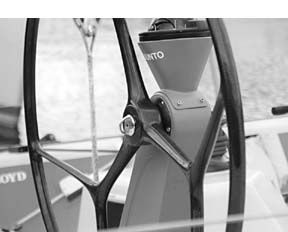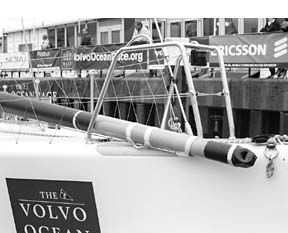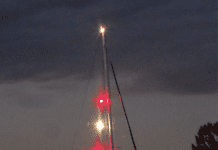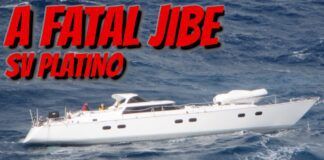What’s the hardest ocean race in the world? For our money, the Volvo Ocean Race—32,000 miles of flat-out racing around the world—has to be pretty near the top of the list. As you read this, nearly 100 of the world’s best men and women sailors are driving eight tough 60-foot boats as hard as they can, 24 hours a day, for weeks on end. They’ll be around in nine months, including pit stops.

What does this race have to do with cruising sailors?
A lot more than you might think. Racers and cruisers share the same ocean, the same weather. They must solve the same problems. They must fix things when they break. Racers and cruisers alike get cold and wet, tired, discouraged, and elated. When you look at a Volvo 60, you look at the near future of ocean cruising.
With their big rigs, deep draft, and open cockpits, no one would consider the Volvo 60 boats to be conservative, but they are in fact very rational oceanracing yachts designed to be relatively easy to handle and sail at high speeds with fairly small crews. They are also among the toughest, most seaworthy sailboatsof their size in the world.
Construction
Volvo 60s are built using foam core and vacuum-bagged pre-preg Kevlar/epoxy laminates. Minimum required panel weights and core densities are specified for allsections of the hull and deck. The boats are designed and built to the criteria of the ABS (American Bureau of Shipping) Guide for Building and Classing OffshoreRacing Yachts.
The hulls are divided into five watertightcompartments, using full-height structural bulkheadsto separate the watertight areas. At the bow, aseparate sealed collision compartment at the waterlineis meant to absorb the impact of collision withfloating debris without violating the watertightintegrity of the rest of the boat.
Likewise, the keels are generally engineered to absorba grounding at 12 knots without tearing off the boats.This is not an easy design task, since the boats havea substantial chunk of their 30,000 pounds of weighthanging on the bottom of a slender steel keel fin.These are tough boats, because they have to be. Onecrewmember nonchalantly told me of launching the boatoff 15-foot waves in 45-knot winds at boatspeeds ofover 20 knots—without fear of damaging the boat in anyway. This is a dramatic improvement overfirst-generation Whitbread 60s, which often limpedinto port with improvised internal bracing andpatches, the boat barely staying afloat.
The internal structure of each boat is highlyproprietary, as the designers put a great deal ofeffort into creating the strongest possible structurewhile keeping the weight to an absolute minimum.Generally speaking, the forward section of each boatis strongly reinforced with longitudinal stringers toabsorb incredible impact loads. These boats are pushedto astonishing speeds and the absolute limit of crewendurance in situations that most cruisers wouldconsider survival conditions.
A broken boat is a slow boat, and these boats cannotafford to be slow. Sponsorship money depends onperformance.
This year, for the first time, the boats are equippedwith carbon fiber masts and booms. Sparmakers had longargued for this change to the Volvo 60 rule, as thecustom-built aluminum masts previously used were justas expensive and considerably lower in strength andperformance characteristics.
That carbon fiber spars are used in this toughest ofoffshore races should make it clear to anyone thatcarbon fiber masts are suited for a serious offshorecruising as well. These are beautifully engineered,conservative rigs that would be equally at home on ahigh-end cruising boat—except for the array ofadjustable backstays.
Sails
North Sails has a monopoly on sails for the Volvorace. All mainsails and headsails are molded 3DLKevlar/Mylar composites.
Mainsails have huge roaches, which means that youcannot have a permanent backstay.
The boats are never sailed directly downwind, sothere are no conventional symmetrical spinnakers.
Safety Equipment
It’s not surprising that safety should be a majorconcern in a race owned by Volvo, the Swedish companywhose automobiles have always had a reputation forbeing among the safest built. Despite the fact thatthe boats look extreme compared to conventionalcruisers and ocean racers, the Volvo 60s are among thesafest boats sailed on any ocean. They are required tohave a minimum range of positive stability of 142degrees, which is far greater than the requirement forany other ocean race.

By comparison, Practical Sailor has always recommended a minimum range of positive stability of at least 120 degrees for ocean cruising. Very few cruising boats have ranges of positive stability approaching that ofa Volvo 60.
All Volvo 60s have vertical transoms withpermanently installed gudgeons for emergency rudders.The size, weight, and construction of the emergencyrudders are defined by the class rules, so that thereare no “toy” arrangements for emergency steering. Wehave rarely seen a cruising boat with proper provisionfor steering if the rudder itself is lost.
Much of the emergency and safety equipment carried by the boats is identical to that carried by any well-equipped cruising boat. Volvo 60s use webbingjackstays along each side of the deck for theattachment of safety harnesses. In addition, all havestrong padeyes bolted through the decks in criticalareas—near the steering wheels and winch pedestals,for example—which allow hooking on for crewmembers who spend lots of time in a single location.
Interestingly, all of the boats also have anattachment point for the helmsman in the middle ofeach steering wheel. The helmsman is usually attachedto this point by a second short tether in addition tothe longer primary harness tether. The reason for this unusual arrangement is simple: These are light boats that get thrown around a lot by seas. In addition, tons of solid water comes over the decks, as there are no cockpit coamings or spray deflectors of any kind. During heavy-air reaching it’s easy for the helmsman to be thrown or washed off the wheel. The short tether makes sure that he or she will be able to regain steering control in extremeconditions.
All the fatalities that have occurred in Whitbreadraces have been the result of man-overboard incidents.These are professional sailors, but they are just asattuned as the rest of us to the danger of goingoverboard.
As you would expect, a lifejacket is required for eachcrewmember. Surprisingly for those accustomed to USrequirements, these lifejackets must be inflatables.Several Volvo personal safety requirements should beemulated by offshore cruising sailors: Each crewmemberis required to carry a high-intensity personal strobeor a pack of miniflares when on deck at night. Eachcrewmember is also required to carry a personal EPIRB,and each boat is equipped with direction-findingequipment to home in on those EPIRBS. These arewrist-mounted units similar in size to a divingcomputer. We’ll look at them more closely in thefuture.
These two requirements should be near the top of theequipment list for offshore cruisers. Personal strobesare a no-brainer. They are inexpensive and light, andthere is no excuse for not carrying them.Personal EPIRBS would be particularly useful for acruising couple. If one person goes overboard, theother has his or her hands full just trying to stopthe boat and turn it around, much less hit the man-overboard button on the GPS and try to maintainvisual contact.
The greatest fear and biggest risk for cruisingcouples is that one of them will fall overboard whilethe other is sleeping. With the windvane or autopilotsteering, you could easily be 10 miles or more down the track before you know there’s a problem. By that time, the chance of finding someone isessentially zero. With a personal EPIRB anddirection-finding equipment, you have a reasonablechance of finding the lost person.
Volvo 60s carry two 12-person liferafts for a crew of12. The reasoning is fairly simple. Despitesubstantial cradles and tie-downs, the large quantityof water coming over the deck means that there is arisk of the liferafts carrying away. With two rafts,you still have a survival craft capable of holding theentire crew even if one raft is lost.
This would be overkill for the average cruising boat.At the same time, many cruising boats have inadequateand vulnerable liferaft installations. All cruisersshould look long and hard at their liferaftinstallations. Can you deploy the raft easily? Is itsecure enough to take a direct hit from a wave if it’s in an exposed location?
Like all ocean racers, Volvo 60s are required tocarry substantial man-overboard equipment in the formof throwable flotation devices. A total of fourlifebouys with lights are required. At least two ofthose must have foam buoyancy, rather than beinginflatable. One of the buoys must be equipped with aflag and pole which floats at least six feet above thewater. Inflatable poles, such as those in the popularMOM modules carried by many boats (includingCalypso) are not recognized as meeting thisrequirement.
Bow pulpits and lifeline stanchions are one areawhere Volvo 60s are less than ideal. In accordancewith Offshore Racing Council minimum requirements,lifelines are only 24 inches high. In order to saveweight, bow pulpits are the absolute minimum in sizenecessary to give the bowman something to hang onto.Lifeline stanchions themselves are larger in diameterthan the one-inch stanchions seen on most cruisingboats, as smaller-diameter stanchions used in the lastWhitbread race were regularly flattened or broken bycrew hanging onto them.
The 24-inch height, however, seems to us to be tooshort. Calypso is equipped with substantial pulpitsand stanchions that are almost 30 inches high, and wewould not want them any shorter.
Storm Sails
Unfortunately, at least one boat in the last Whitbreadrace did not take the storm sail requirementsseriously, and showed up with tiny, inadequate sailswhose purpose was to meet the letter of the lawwithout being large enough or heavy enough forreal-life use. This time, the class rule specifiesmaximum sizes, minimum sizes, and minimum cloth weight for storm sails. High-visibility colors are also required on the storm sails.

The storm sails seen on most cruising boats—if they’recarried at all—are often built without seriousregard for the real-life requirements of storm sails.Last year, North Sails New Zealand built us anall-purpose storm staysail to the maximum sizepermitted under Offshore Racing Council specificationsfor storm jibs. This sail is designed to carry theboat upwind in extreme conditions. It is cut with aproper shape for upwind sailing, and is equipped withtelltales for proper trim.
We use this sail regularly as a working upwindheadsail in winds of 30 knots or more. It sets betterthan a reefed genoa, keeps the boat in balance, and isa powerful sail. In extreme conditions, it can bereefed, as it sets on oversized furling gear. Wehave used this sail in a partially reefedconfiguration several times in winds of 40 knots ormore, and are convinced that it is the way to go for astorm headsail on an offshore cruiser.
Batteries and Charging
In addition to the Volvo propulsion engine, the boatsare equipped with a smaller Volvo auxiliary to powerequipment such as alternators, watermakers, andballast transfer pumps. The boats are required tocarry two high-output alternators adapted for use byeither the main engine or the auxiliary.
Liquid electrolyte batteries are not permitted in Volvo 60s. Severe knockdowns are considered a normal risk in this type of racing, and liquid electrolyte batteries could be a serious hazard in a capsize. Most boats use a simple Link 10 battery monitor to keep track of electrical usage. All boats carry Inmarsat B systems with belowdecks antennas for primary communications with the race organizers, plus smaller Mini-M systems mounted above deck. Electrical demands for communication systems are very high. Big battery banks—almost 620 pounds of batteries—are required, along with the big alternators keep the juice flowing.
Comfort
A Volvo 60 may be a boat built for speed and safety,but it is not a boat built for comfort. With 15 ormore sails carried belowdecks, there’s no standingheadroom at sea, despite the relatively large internalvolume of the boats.
On most boats, there’s effectively no ventilationbelowdecks in heavy weather, except for a few smallvents located in the cockpit sidewall. There are nodorade vents or opening ports. Some boats have a smallhatch over the navigator’s station, but it’s reallyintended for communication rather than ventilation.
Mesh-bottom pipe berths are small and uncomfortable,with no cushions or pillows. Fatigue, rather thancomfort, lulls you to sleep. You sleep in any locationthat enhances performance, and it’s not uncommon tobe required to shift berths in the middle of theoff-watch.
Toilets are generally custom made to be light andsmall. They have no seats. On a few boats, there’s aprivacy curtain for the toilet, which is alwayslocated forward.
The galley consists of a single gimballed burner withan attached tank of butane. There’s a single cookingpot. There are very few lights. All of this is in the name of saving weight.
Each boat has a watermaker, which is used daily. Onlya nominal amount of water is carried in the watertanks. Watermaker problems in the last Whitbread Raceproduced potentially dangerous shortages onseveral boats.
Because a lot of sailing is done in high latitudes,the rules require each boat to be equipped with asmall diesel-fired heater. In the last race crewssuffered badly from cold on several of the legs.
Electronics
Except for the extensive communication systems, theelectronics package is small compared to the typicalcruising boat of this size. All boats must carryradars of at least three kilowatts output, withradomes at least 24 inches in diameter. Most carry thesmallest, lightest radar that will meet thisspecification. The Raytheon RL70 Pathfinder is apopular unit due to its light weight.
Most boats are equipped with the Leica MK 10differential GPS, although a few use Northstar 941 or951XD units. Both the Northstar and Leica units areabsolutely top-of-the-line machines. All the boats use B&G Hercules 2000 instrumentation systems with proprietary performance software. A variety of brands and types of VHF and SSB radios are carried.
Every boat also carries a Vetus Meteoliner electronicrecording barograph. A barograph is a critical pieceof forecasting equipment. The Meteoliner islightweight, and unlike a mechanical recordingbarograph, is not affected by motion.
All boats carry direct-download satellite weathersystems. A variety of these are used, from simple toexpensive. We will be very interested to see how theseare utilized during the race, and will look moreclosely at them as the race progresses.
Conclusions
The Volvo 60s are designed to be sailed byprofessional sailors in a hard-driving race around theworld. They are high-performance boats, but they arenot really extreme. A reconfigured Volvo60 with conventional deckhouse, smaller cockpit with proper protection, electric winches, furling headsails, bigger tanks, heavier and shallower keel, simplifiedrig, would make a reasonably comfortable and spaciouscruising boat.
No, two people could not sail one of these boats aswell as a crew of 12 professional men or womensailors. Mom and Pop aren’t going to knock off many400-mile days in a re-configured Volvo 60. However,even an overloaded, detuned Volvo 60 with acomfortable interior could regularly turn in24-hour runs of over 250 miles.
If that prospect sounds interesting, be at the finishline in Europe next summer with your checkbook inhand. But remember: this is definitely not yourmother’s Volvo.









































